扩频通信系统的MATLAB仿真
直接序列扩频系统matlab仿真
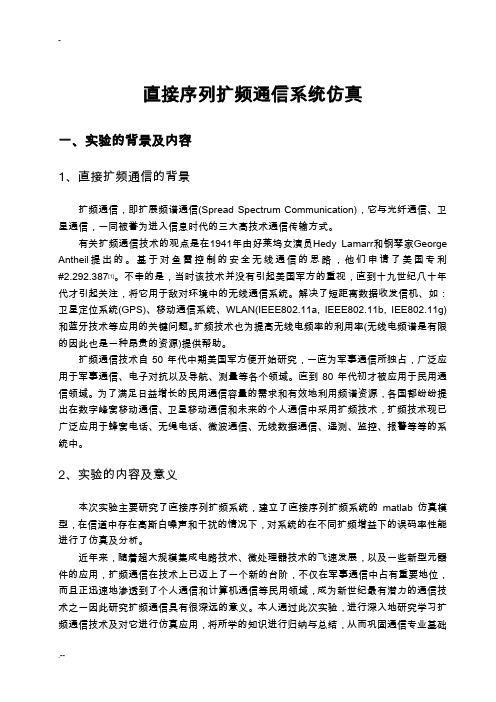
直接序列扩频通信系统仿真一、实验的背景及内容1、直接扩频通信的背景扩频通信,即扩展频谱通信(Spread Spectrum Communication),它与光纤通信、卫星通信,一同被誉为进入信息时代的三大高技术通信传输方式。
有关扩频通信技术的观点是在1941年由好莱坞女演员Hedy Lamarr和钢琴家George Antheil提出的。
基于对鱼雷控制的安全无线通信的思路,他们申请了美国专利#2.292.387[1]。
不幸的是,当时该技术并没有引起美国军方的重视,直到十九世纪八十年代才引起关注,将它用于敌对环境中的无线通信系统。
解决了短距离数据收发信机、如:卫星定位系统(GPS)、移动通信系统、WLAN(IEEE802.11a, IEEE802.11b, IEE802.11g)和蓝牙技术等应用的关键问题。
扩频技术也为提高无线电频率的利用率(无线电频谱是有限的因此也是一种昂贵的资源)提供帮助。
扩频通信技术自50年代中期美国军方便开始研究,一直为军事通信所独占,广泛应用于军事通信、电子对抗以及导航、测量等各个领域。
直到80年代初才被应用于民用通信领域。
为了满足日益增长的民用通信容量的需求和有效地利用频谱资源,各国都纷纷提出在数字峰窝移动通信、卫星移动通信和未来的个人通信中采用扩频技术,扩频技术现已广泛应用于蜂窝电话、无绳电话、微波通信、无线数据通信、遥测、监控、报警等等的系统中。
2、实验的内容及意义本次实验主要研究了直接序列扩频系统,建立了直接序列扩频系统的matlab仿真模型,在信道中存在高斯白噪声和干扰的情况下,对系统的在不同扩频增益下的误码率性能进行了仿真及分析。
近年来,随着超大规模集成电路技术、微处理器技术的飞速发展,以及一些新型元器件的应用,扩频通信在技术上已迈上了一个新的台阶,不仅在军事通信中占有重要地位,而且正迅速地渗透到了个人通信和计算机通信等民用领域,成为新世纪最有潜力的通信技术之一因此研究扩频通信具有很深远的意义。
基于matlab的直序扩频通信系统的仿真设计
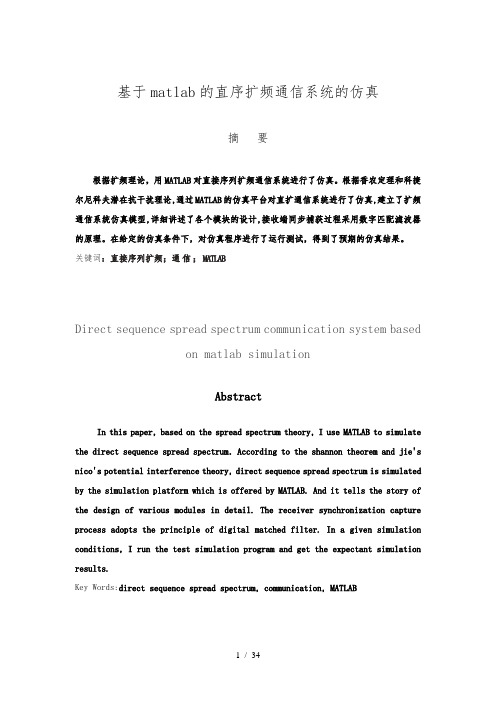
基于matlab的直序扩频通信系统的仿真摘要根据扩频理论,用MATLAB对直接序列扩频通信系统进行了仿真。
根据香农定理和科捷尔尼科夫潜在抗干扰理论,通过MATLAB的仿真平台对直扩通信系统进行了仿真,建立了扩频通信系统仿真模型,详细讲述了各个模块的设计,接收端同步捕获过程采用数字匹配滤波器的原理。
在给定的仿真条件下,对仿真程序进行了运行测试,得到了预期的仿真结果。
关键词:直接序列扩频;通信;MATLABDirect sequence spread spectrum communication system basedon matlab simulationAbstractIn this paper, based on the spread spectrum theory, I use MATLAB to simulate the direct sequence spread spectrum.According to the shannon theorem and jie's nico's potential interference theory, direct sequence spread spectrum is simulated by the simulation platform which is offered by MATLAB. And it tells the story of the design of various modules in detail. The receiver synchronization capture process adopts the principle of digital matched filter. In a given simulation conditions, I run the test simulation program and get the expectant simulation results.Key Words:direct sequence spread spectrum, communication, MATLAB目录1绪论31.1 扩频通信的概述31.2扩频通信的发展与应用32 直接序列扩频通信52.1理论基础52.2扩频通信系统的指标62.3扩频通信的种类72.4直接序列扩频通信系统72.5 扩频序列122.6 扩频序列的同步捕获162.6.1 扩频序列的伪码同步162.6.2 扩频序列的同步捕获173 直接扩频系统MATLAB仿真263.1 直接扩频MATLAB仿真组成框图263.2 m序列发生器263.3 高斯噪声263.4干扰和解扩判决273.5仿真结果分析273.6实验心得29附录29参考文献32致331 绪论1.1 扩频通信的概述扩频通信与光纤通信、卫星通信一同被誉为进入信息时代的三大高技术通信传输方式,它是指发送的信息被展宽到一个很宽的频带上,在接收端通过相关接收,将信号恢复到信息带宽的一种系统[1]。
直接扩频系统的MATLAB仿真
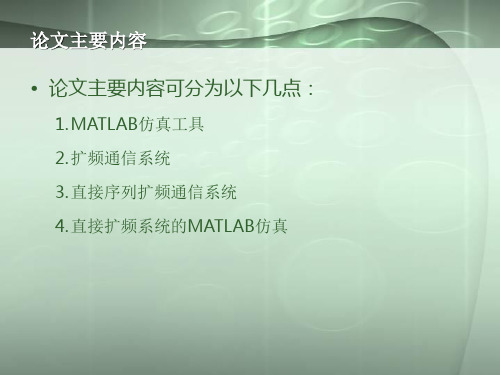
扩频通信系统
• 扩频通信的基本特点,是传输信号所占用的频带 宽度(W)远大于原始信息本身实际所需的最小(有 效)带宽(F),其比值称为处理增益Gp。 • 扩频通信的可行性,是从信息论和抗干扰理论的 基本公式中引伸而来的。信息论中关于信息容量 的香农(Shannon)公式为:
C WLong
2
(1 P / N )
请老师批评指正!
答辩结束
直接扩频系统的MATLAB仿真
• 解扩后的数据
致谢
• 毕设期间我遇到很多问题,在此,很感谢老师同 学们给予我各方面的帮助,特别要感谢我的指导 老师,王鲁杰老师,王老师的细心和认真的工作 态度是值得我们每个人学习的,从开题到现在, 在王老师的指导下,我懂得了太多东西,相信这 些在我今后的学习生活中都有着非常重要的意义。 • 另外虽然本次设计基本顺利完成,但是其中任然 存在很多问题,还望老师体谅。
• 式中: C --- 信道容量(用传输速率度量) W --- 信号频带宽度 P --- 信号功率 N --- 白噪声功率
扩频通信系统
• 扩频通信的主要特点: 1. 抗干扰性强,误码率低 2. 易于同频使用,提高了无线频谱利用率 3. 抗多径干扰;可以实现码分多址 4. 隐蔽性好,对各种窄带通信系统的干扰很小 5. 扩频通信自身具有加密功能,保密性强,便于开 展各种通信业务 6. 扩频通信安装简便,易于维护,也十分小巧可靠, 便于安装,便于扩展 7. 扩频设备一般采用积木式结构,组网方式灵活, 方便统一规划,分期实施,利于扩容。
论文主要内容
• 论文主要内容可分为以下几点:
1. MATLAB仿真工具
2. 扩频通信系统
3. 直接序列扩频通信系统
4. 直接扩频系统的MATLAB仿真
基于MATLAB的扩频和调频通信系统仿真
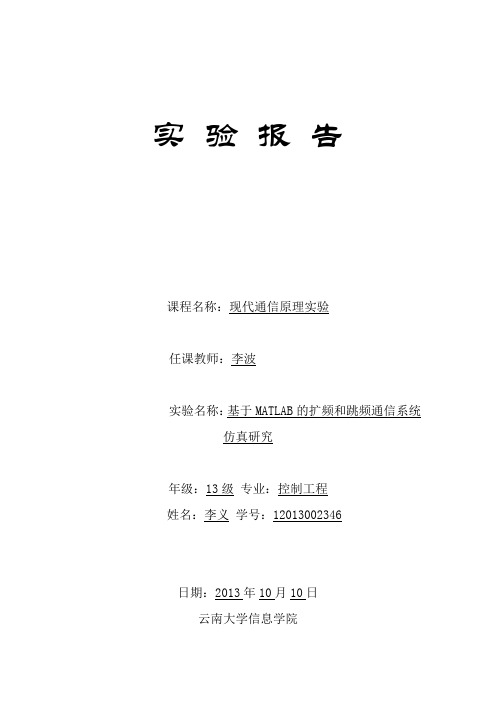
实验报告课程名称:现代通信原理实验任课教师:李波实验名称:基于MATLAB的扩频和跳频通信系统仿真研究年级:13级专业:控制工程姓名:李义学号:12013002346日期:2013年10月10日云南大学信息学院一、 实验目的根据通信理论知识熟练的运用MATLAB 进行直序列扩频和跳频扩频的仿真研究。
二、 实验内容1.Matlab/simulink 通信系统仿真。
2.用matlab 实现直序列扩频和跳频扩频。
三、 实验平台硬件平台:笔记本电脑软件平台:windows7操作系统、Matlab R2013a四、扩展频谱通信知识1.理论基础通信技术和通信理论的研究,是围绕着通信系统的有效性和可靠性这两个基本问题开展的。
所以,有效性和可靠性是设计和评价一个通信系统的主要性能指标。
有效性,是指通信系统传输信息效率的高低。
这个问题是讨论怎样以最合理、最经济的方法传输最大数量的信息。
在模拟通信系统中,多路复用技术可提高系统的有效性。
显然,信道复用程度越高,系统传输信息的有效性就越好。
在数字通信系统中,由于传输的是数字信号,因此传输的有效性是用传输速率来衡量的。
可靠性,是指通信系统可靠地传输信息。
由于信息在传输过程中受到干扰,收到的与发出的信息并不完全相同。
可靠性就是用来衡量收到信息与发出信息的符合程度。
因此,可靠性决定于系统抵抗干扰的性能,也就是说,决定于通信系统的抗干扰性。
在模拟通信系统中,传输可靠性是用整个系统的输出信噪比来衡量的。
在数字通信系统中,传输可靠性是用差错率来衡量的。
扩展频谱通信由于具有很强的抗干扰能力,首先在军用通信系统中得到了应用。
近年来,扩展频谱通信技术的理论和应用发展非常迅速。
扩频通信是扩展频谱通信的简称。
我们知道,频谱是电信号的频域描述。
承载各种信息(如语音、图象、数据等)的信号一般都是以时域来表示的,即表示为一个时间的函数)(t f 。
信号的时域表示式)(t f 可以用傅立叶变换得到其频域表示式)(f F 。
扩频通信系统仿真实验报告

扩频通信系统仿真实验报告一、引言扩频通信是一种通过扩展信号带宽来传输信息的技术。
在扩频通信系统中,发送方将待传输的信息数据序列与扩频码序列相乘,再通过信道传输到接收方。
接收方通过与发送方使用相同的扩频码序列相乘,并将结果进行积分操作,从而将扩频信号提取出来。
本文通过MATLAB软件使用数字仿真的方法,对扩频通信系统进行了仿真实验,包括扩频信号的产生、传输和提取等过程,最后通过性能指标评估扩频通信系统的性能。
二、实验内容1.扩频信号的产生:首先生成待传输的数字信息序列,然后与扩频码进行点乘产生扩频信号。
2.信道传输:模拟信道传输过程,包括加性高斯白噪声(AWGN)等噪声影响。
3.扩频信号的提取:接收方使用与发送方相同的扩频码对接收到的信号进行点乘与积分操作,从而提取出扩频信号。
4.性能评估:通过比较接收信号与发送信号的相关性和误码率等性能指标来评估扩频通信系统的性能。
三、实验步骤1.扩频信号的产生:首先生成随机的数字信息序列,然后使用伪随机序列作为扩频码与数字信息序列相乘,产生扩频信号。
2.信道传输:将扩频信号通过信道传输,并添加加性高斯白噪声模拟噪声影响。
3.扩频信号的提取:接收方使用与发送方相同的扩频码对接收到的信号进行点乘与积分操作,提取出扩频信号。
4.性能评估:通过计算接收信号与发送信号的相关性和统计误码率等性能指标来评估扩频通信系统的性能。
实验结果展示4.性能评估:通过计算接收信号与发送信号的相关性和统计误码率等性能指标来评估扩频通信系统的性能。
相关性较高且误码率较低表示系统性能较好。
四、实验结论通过本次扩频通信系统的仿真实验,我们可以得出以下结论:1.扩频通信系统能够有效抵抗噪声影响,提高信道的抗干扰能力。
2.扩频码的选择对系统性能有较大影响,合适的扩频码可以提高系统性能。
3.扩频通信系统的误码率与信噪比有关,当信噪比较高时,系统的误码率较低。
总之,扩频通信系统在信息传输中具有较好的性能和鲁棒性,通过对其进行仿真实验可以更好地理解其工作原理和性能特点。
matlab扩频通信仿真代码

《MATLAB扩频通信仿真代码探究》一、概述MATLAB是一种功能强大的数学软件工具,广泛应用于科学和工程领域。
扩频通信是一种在通信系统中应用较多的技术,能够提高通信系统的安全性和抗干扰性。
本文将就MATLAB中扩频通信仿真代码进行探究,以了解其原理和实现。
二、扩频通信技术简介扩频通信是通过在发送端用高速码对数据进行调制,从而增大信号带宽,提高信噪比,以实现更可靠的数据传输。
在接收端,可以利用相同的高速码进行解调,将信号还原为原始数据。
扩频通信技术包括直接序列扩频(DSSS)和正交频分复用(OFDM)等多种方式。
三、MATLAB中的扩频通信仿真代码在MATLAB中,可以利用其丰富的工具箱和函数库,快速实现扩频通信系统的仿真。
通过编写相应的代码,可以模拟扩频通信系统中的传输、接收、信道建模等过程,对系统性能进行评估和优化。
我们需要定义扩频序列,可以选择PN序列或者其他扩频序列。
在发送端,利用扩频序列对数据进行调制,形成扩频信号。
接下来,在信道模型中加入噪声和干扰,模拟真实通信环境。
在接收端,利用相同的扩频序列进行解调,将信号恢复为原始数据。
通过仿真可以得到系统的误码率、传输速率、抗干扰性等性能参数,对系统进行优化和改进。
四、个人观点和理解扩频通信技术在现代通信系统中起着重要作用,其在军事通信、无线网络、卫星通信等领域有着广泛的应用。
利用MATLAB的强大功能,可以快速进行扩频通信系统的仿真和分析,为工程实践提供重要参考。
通过深入学习和探究MATLAB中的扩频通信仿真代码,可以更好地理解扩频通信技术的原理和实现方法,为相关领域的研究和开发提供有力支持。
在总结回顾本文内容时,我们了解了MATLAB中扩频通信仿真代码的实现原理和应用。
通过对扩频通信技术的深入学习和实践,可以更好地掌握通信系统的设计和优化方法,为信息通信领域的发展贡献力量。
总结:通过对MATLAB扩频通信仿真代码的探究,我们深刻理解了扩频通信技术的原理和实现方法,并认识到MATLAB在通信系统仿真中的重要作用。
基于MATLAB的扩频通信系统仿真
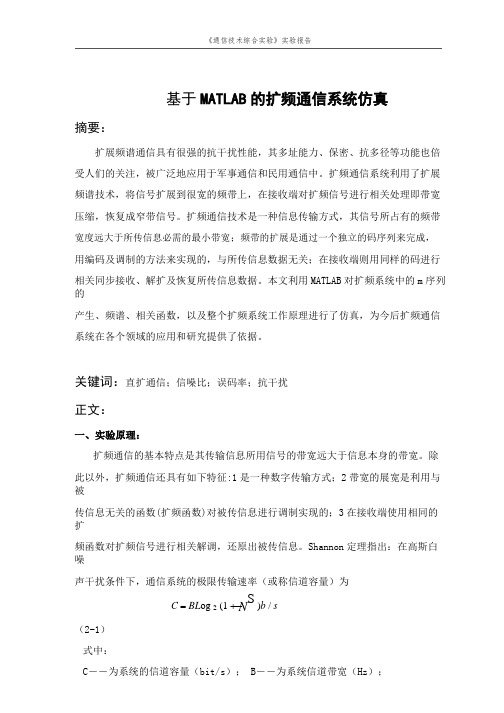
《通信技术综合实验》实验报告基于MATLAB 的扩频通信系统仿真摘要:扩展频谱通信具有很强的抗干扰性能,其多址能力、保密、抗多径等功能也倍受人们的关注,被广泛地应用于军事通信和民用通信中。
扩频通信系统利用了扩展频谱技术,将信号扩展到很宽的频带上,在接收端对扩频信号进行相关处理即带宽压缩,恢复成窄带信号。
扩频通信技术是一种信息传输方式,其信号所占有的频带宽度远大于所传信息必需的最小带宽;频带的扩展是通过一个独立的码序列来完成,用编码及调制的方法来实现的,与所传信息数据无关;在接收端则用同样的码进行相关同步接收、解扩及恢复所传信息数据。
本文利用MATLAB 对扩频系统中的m 序列的产生、频谱、相关函数,以及整个扩频系统工作原理进行了仿真,为今后扩频通信系统在各个领域的应用和研究提供了依据。
关键词:直扩通信;信噪比;误码率;抗干扰正文:一、实验原理:扩频通信的基本特点是其传输信息所用信号的带宽远大于信息本身的带宽。
除此以外,扩频通信还具有如下特征:1是一种数字传输方式;2带宽的展宽是利用与被传信息无关的函数(扩频函数)对被传信息进行调制实现的;3在接收端使用相同的扩频函数对扩频信号进行相关解调,还原出被传信息。
Shannon 定理指出:在高斯白噪声干扰条件下,通信系统的极限传输速率(或称信道容量)为C = BL og 2 (1 + N S)b / s(2-1)式中:C――为系统的信道容量(bit/s ); B――为系统信道带宽(Hz );S――为信号的平均功率;N――为噪声功率由式中可以看出。
若白噪声的功率谱密度为n0,噪声功率N=nB ,则信道容量C可表示为:1《通信技术综合实验》实验报告C = BLog 2(1+S)b / s n0 B(2-2)由上式可以看出,B、n0、S确定后,信道容量C就确定了。
由Shannon第二定理知,若信源的信息速率小于或等于信道容量C,通过编码,信源的信息能以任意小的差错概率通过信道传输。
直接序列扩频系统MATLAB仿真(BPSK调制)

目录一、背景 (4)二、基本要求 (4)三、设计概述 (4)四、Matlab设计流程图 (5)五、Matlab程序及仿真结果图 (6)1、生成m序列及m序列性质 (6)2、生成50位随机待发送二进制比特序列,并进行扩频编码 (7)3、对扩频前后信号进行BPSK调制,观察其时域波形 (9)4、计算并观察扩频前后BPSK调制信号的频谱 (10)5、仿真经awgn信道传输后,扩频前后信号时域及频域的变化 (11)6、对比经信道前后两种信号的频谱变化 (12)7、接收机与本地恢复载波相乘,观察仿真时域波形 (14)8、与恢复载波相乘后,观察其频谱变化 (15)9、仿真观察信号经凯萨尔窗低通滤波后的频谱 (16)10、观察经过低通滤波器后无扩频与扩频系统的时域波形 (17)11、对扩频系统进行解扩,观察其时域频域 (18)12、比较扩频系统解扩前后信号带宽 (19)13、比较解扩前后信号功率谱密度 (20)14、对解扩信号进行采样、判决 (21)15、在信道中加入2040~2050Hz窄带强干扰并乘以恢复载波 (24)16、对加窄带干扰的信号进行低通滤波并解扩 (25)17、比较解扩后信号与窄带强干扰的功率谱 (27)六、误码率simulink仿真 (28)1、直接扩频系统信道模型 (28)2、加窄带干扰的直扩系统建模 (29)3、用示波器观察发送码字及解扩后码字 (30)4、直接扩频系统与无扩频系统的误码率比较 (31)5、不同扩频序列长度下的误码率比较 (32)6、扩频序列长度N=7时,不同强度窄带干扰下的误码率比较 (33)七、利用Walsh码实现码分多址技术 (34)1、产生改善的walsh码 (35)2、产生两路不同的信息序列 (36)3、用两个沃尔什码分别调制两路信号 (38)4、两路信号相加,并进行BPSK调制 (39)5、观察调制信号频谱,并经awgn信道加高斯白噪和窄带强干扰 (40)6、接收机信号乘以恢复载波,观察时域和频域 (42)7、信号经凯萨尔窗低通滤波器 (43)8、对滤波后信号分别用m1和m2进行解扩 (44)9、对两路信号分别采样,判决 (45)八、产生随机序列Gold码和正交Gold码 (47)1、产生Gold码并仿真其自相关函数 (48)2、产生正交Gold码并仿真其互相关函数 (50)九、实验心得体会 (51)直接序列扩频系统仿真一、背景直接序列扩频通信系统(DSSS)是目前应用最为广泛的系统。
基于matlab的直接序列扩频通信系统仿真
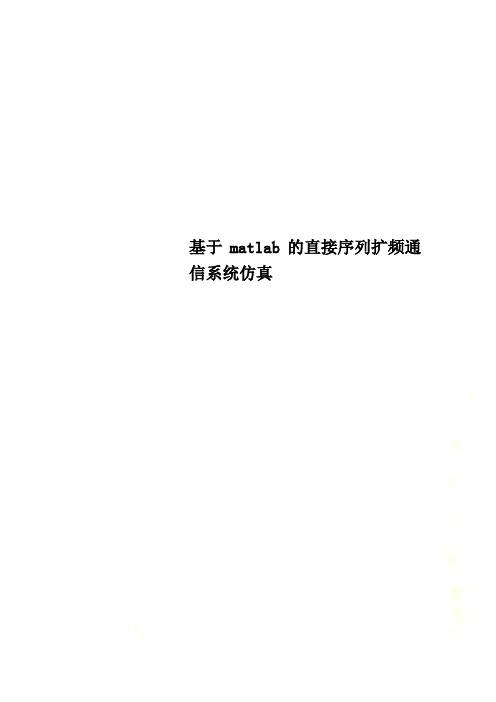
基于matlab的直接序列扩频通信系统仿真基于MATLAB的直接序列扩频通信系统仿真1.实验原理:直接序列扩频(DSSS)是直接利用具有高码率的扩频码系列采用各种调制方式在发端与扩展信号的频谱,而在收端,用相同的扩频码序去进行解扩,把扩展宽的扩频信号还原成原始的信息。
它是一种数字调制方法,具体说,就是将信源与一定的PN码(伪噪声码)进行摸二加。
例如说在发射端将"1"用11000100110,而将"0"用00110010110去代替,这个过程就实现了扩频,而在接收机处只要把收到的序列是11000100110就恢复成"1"是00110010110就恢复成"0",这就是解扩。
这样信源速率就被提高了11倍,同时也使处理增益达到 10DB以上,从而有效地提高了整机倍噪比。
1.1 直扩系统模型直接序列扩频系统是将要发送的信息用伪随机码(PN码)扩展到一个很宽的频带上去,在接收端用与发送端相同的伪随机码对接收到的扩频信号进行相关处理,恢复出发送的信号。
对干扰信号而言,与伪随机码不相关,在接收端被扩展,使落入信号通频带内的干扰信号功率大大降低,从而提高了相关的输出信噪比,达到了抗干扰的目的。
直扩系统一般采用频率调制或相位调制的方式来进行数据调制,在码分多址通信中,其调制多采用BPSK、DPSK、QPSK、MPSK 等方式,本实验中采取BPSK方式。
直扩系统的组成如图1所示,与信源输出的信号a(t)是码元持续时间为Ta的信息流,伪随机码产生器产生伪随机码c(t),每个伪随机码的码元宽度为Tc (Tc<<Ta)。
将信息码与伪随机码进行相乘或模二加,产生一速率与伪随机码速率相同的扩频序列,这时信息带宽已经被展宽(如图2b),然后用扩频序列去调制载波,则信号频谱被搬移到射频上(如图2c )。
在接收端,接收到的信号经混频后,用与发射同步的伪随机码对中频信号进行相关解扩,将信号的频带恢复为信息的频带,然后再进行解调,恢复出所传送的信息a(t)。
基于matlab的直接序列扩频通信系统仿真1

基于直接扩频序列技术的BPSK系统的仿真设计报告摘要:本文首先介绍了直接序列扩频系统的模型,然后概要阐述了常用的伪随机码以及扩频技术的优点,最后利用MATLAB对BPSK直扩系统进行了仿真。
关键词:直接序列扩频;伪随机码;BPSK;仿真1 引言扩频技术是扩展频谱通信(SSC—Spread Spectrum Communication)的简称,它是随着在军事通信中的应用发展起来的,由于其具有其它一般通信方式不具备的抗于扰强,抗多径衰落好,保密性好等一系列的优点,因此近年来它在民用通信中的应用也开始越来越受到人们的重视。
这次主要研究扩频通信系统中常用直接扩频序列技术的BPSK系统调制方式。
2 直接序列扩频系统直接序列扩频系统又称为直接序列调制系统或伪噪声系统(PN系统),简称为直扩系统,是目前应用较为广泛的一种扩展频谱系统。
人们对直扩系统的研究最早,如美军的国防卫星通信系统(AN-VSC-28)、全球定位系统(GPS)、航天飞机通信用的跟踪和数据中继卫星系统(TDRSS)等都是直扩技术应用的实例。
2.1直扩系统模型直接序列扩频系统是将要发送的信息用伪随机码(PN码)扩展到一个很宽的频带上去,在接收端用与发送端相同的伪随机码对接收到的扩频信号进行相关处理,恢复出发送的信号。
对干扰信号而言,与伪随机码不相关,在接收端被扩展,使落入信号通频带内的干扰信号功率大大降低,从而提高了相关的输出信噪比,达到了抗干扰的目的。
直扩系统一般采用频率调制或相位调制的方式来进行数据调制,在码分多址通信中,其调制多采用BPSK、DPSK、QPSK、MPSK等方式。
直扩系统的组成如图1所示,与信源输出的信号a(t)是码元持续时间为Ta的信息流,伪随机码产生器产生伪随机码c(t),每个伪随机码的码元宽度为Tc (Tc<<Ta)。
将信息码与伪随机码进行相乘或模二加,产生一速率与伪随机码速率相同的扩频序列,这时信息带宽已经被展宽(如图2b),然后用扩频序列去调制载波,则信号频谱被搬移到射频上(如图2c )。
直接序列扩频通信系统的MATLAB仿真毕业论文

直接序列扩频通信系统的MATLAB仿真毕业论文摘要直接扩频序列调制是用速率很高的伪噪声码序列与信息码序列模二相加后(波形相乘)得带复合码序列,用复合码序列去制载波相位,从而获得直接扩频序列信号的。
直接扩频通信具有低截获概率、抗干扰能力强以及易于实现码分多址等优点,在抗干扰通信及民用移动通信中都得到了广泛的应用。
先阐述了扩频通信的基本原理、主要性能指标及其工作特点,然后根据香农定理在抗下扰理论,借助工具箱和仿真算法,建立了直接序列扩频通信系统仿真模型。
通过分析无干扰时的误码率仿真曲线与理论计算值,证明了所建仿真模型的正确性。
在MATLAB程序仿真部分,主要分为6大部分,分别为主函数,发送模块,接收模块,AWNG信道,Walsh函数和差错计数器。
通过主函数对各个子函数的调用,实现4个用户的随机数据的发送和接收,同时生成前4个用户在整个传输过程中的各种波形变化图,并对系统信噪比与误码率关系进行分析。
扩频通信是通信的一个重要分支和信道通信系统的发展方向。
扩频技术具有抗干扰能力强,保密性好,易于实现多址通信等优点,因此该技术越来越受到人们的重视,这也是选择本次课题研究的原因所在。
关键词:直接序列扩频信号,通信,MATLABABSTRACTDirect-sequence spread spectrum transmitters (DS-SS) use a periodical pseudo-random sequence (PN sequence) to modulate the baseband signal,and exploit the modulated signal to control the phase of carrier wave. Because DS signals show many advantages such as anti-jamming capability. low probability of interception. multiple access capability and so on. direct sequence spread spectrum signals have been widely applied for secure communications and mobile communications known as Code Division Multiple Access System.This thesis expounds the basic principles of spread spectrum communication, and then article mainly acts according to the Shannon theorem.with the aid of matlab toolbox. it has established the direct sequence spread spectrum communications system simulation model which does not have when the disturbance through the analysis corror rate simulation curve and theory predicted value, had proven constructs the simulation model the accuracy.In the MATLAB simulation part, mainly divides into six parts, respectively is given priority to function, sending module, receiving module, AWNG channel, Walsh function and error counter. Through the main function of each function call, realize four user random data sending and receiving, at the same time generate before four users throughout the various waveform variation in the process of transmission, and the relationship between signal to noise ratio and bit error rate of the system were analyzed.Spread spectrum communication is an important branch of communication and channel development direction of communication system. Spread spectrum technology has the features such as strong anti-jamming capability, the secrecy good, the advantages of easy to realize multiple access communication, therefore the technology more and more get the attention of people, this is also why choose this topic research.第一章绪论人类社会进入到了信息社会,通信现代化是人类社会进入信息时代的重要标志。
直接扩频Matlab仿真实验报告m序列
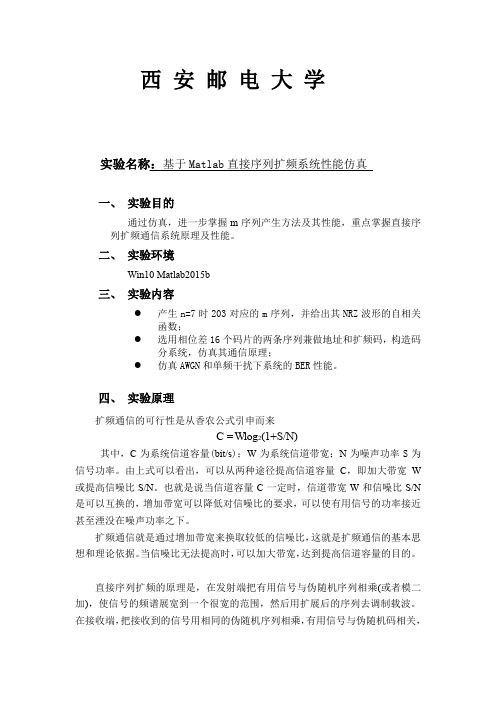
西 安 邮 电 大 学实验名称:基于Matlab 直接序列扩频系统性能仿真一、 实验目的通过仿真,进一步掌握m 序列产生方法及其性能,重点掌握直接序列扩频通信系统原理及性能。
二、 实验环境Win10 Matlab2015b三、 实验内容● 产生n=7时203对应的m 序列,并给出其NRZ 波形的自相关函数;● 选用相位差16个码片的两条序列兼做地址和扩频码,构造码分系统,仿真其通信原理;●仿真AWGN 和单频干扰下系统的BER 性能。
四、 实验原理扩频通信的可行性是从香农公式引申而来2log (1+S/N)C W其中,C 为系统信道容量(bit/s );W 为系统信道带宽;N 为噪声功率S 为信号功率。
由上式可以看出,可以从两种途径提高信道容量C ,即加大带宽W 或提高信噪比S/N 。
也就是说当信道容量C 一定时,信道带宽W 和信噪比S/N 是可以互换的,增加带宽可以降低对信噪比的要求,可以使有用信号的功率接近甚至湮没在噪声功率之下。
扩频通信就是通过增加带宽来换取较低的信噪比,这就是扩频通信的基本思想和理论依据。
当信噪比无法提高时,可以加大带宽,达到提高信道容量的目的。
直接序列扩频的原理是,在发射端把有用信号与伪随机序列相乘(或者模二加),使信号的频谱展宽到一个很宽的范围,然后用扩展后的序列去调制载波。
在接收端,把接收到的信号用相同的伪随机序列相乘,有用信号与伪随机码相关,相乘后恢复为扩频前的信号。
输入的数据信息为d(t)(设基带带宽为B 1),由伪随机编码(如m 序列)调制成基带带宽为B 2的宽带信号,由于扩频信号带宽大于数据信号带宽,所以信号扩展的带宽由伪随机码控制,而与数据信号无关。
经扩频调制的信号再经射频调制后即可发送。
直扩系统的原理框图接收端收到发送来的信号,经混频得到中频信号后,首先通过同步电路捕捉并跟踪发端伪码的准确相位,由此产生与发端伪码相位完全一致的伪随机码作为扩频解扩的本地扩频码,再与中频信号进行相关解扩,恢复出扩频前的窄带信号,而在解扩处理中,干扰和噪声与伪随机码不相关故被扩展,通过滤波使之受到抑制,这样就可在较高的解扩输出信噪比条件下进行信息解调解码,最终获得信息数据。
基于MATLAB的扩频通信系统及同步性能仿真
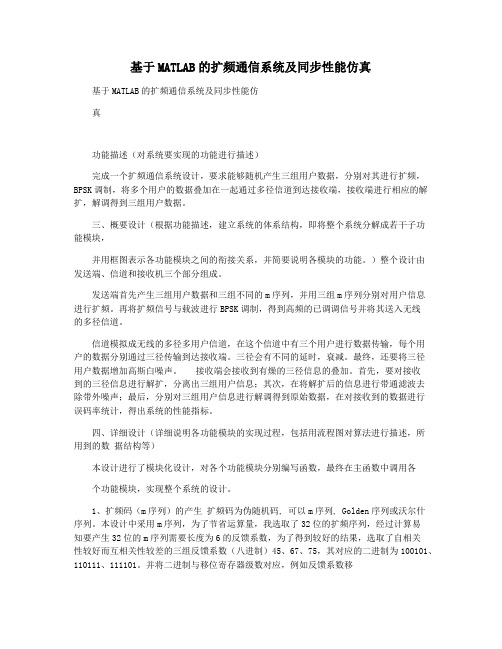
基于MATLAB的扩频通信系统及同步性能仿真基于MATLAB的扩频通信系统及同步性能仿真功能描述(对系统要实现的功能进行描述)完成一个扩频通信系统设计,要求能够随机产生三组用户数据,分别对其进行扩频,BPSK调制,将多个用户的数据叠加在一起通过多径信道到达接收端,接收端进行相应的解扩,解调得到三组用户数据。
三、概要设计(根据功能描述,建立系统的体系结构,即将整个系统分解成若干子功能模块,并用框图表示各功能模块之间的衔接关系,并简要说明各模块的功能。
)整个设计由发送端、信道和接收机三个部分组成。
发送端首先产生三组用户数据和三组不同的m序列,并用三组m序列分别对用户信息进行扩频。
再将扩频信号与载波进行BPSK调制,得到高频的已调调信号并将其送入无线的多径信道。
信道模拟成无线的多径多用户信道,在这个信道中有三个用户进行数据传输,每个用户的数据分别通过三径传输到达接收端。
三径会有不同的延时,衰减。
最终,还要将三径用户数据增加高斯白噪声。
接收端会接收到有燥的三径信息的叠加。
首先,要对接收到的三径信息进行解扩,分离出三组用户信息;其次,在将解扩后的信息进行带通滤波去除带外噪声;最后,分别对三组用户信息进行解调得到原始数据,在对接收到的数据进行误码率统计,得出系统的性能指标。
四、详细设计(详细说明各功能模块的实现过程,包括用流程图对算法进行描述,所用到的数据结构等)本设计进行了模块化设计,对各个功能模块分别编写函数,最终在主函数中调用各个功能模块,实现整个系统的设计。
1、扩频码(m序列)的产生扩频码为伪随机码, 可以m序列, Golden序列或沃尔什序列。
本设计中采用m序列,为了节省运算量,我选取了32位的扩频序列,经过计算易知要产生32位的m序列需要长度为6的反馈系数,为了得到较好的结果,选取了自相关性较好而互相关性较差的三组反馈系数(八进制)45、67、75,其对应的二进制为100101、110111、111101。
基于某MATLAB地扩频通信仿真

基于MATLAB的扩频通信仿真1 1.仿真原理扩展频谱通信具有很强的抗干扰性,其多址能力、保密、抗多径等功能也倍受人们的关注,被广泛的应用于军事通信和民用通信中。
扩频技术,将信号扩展到很宽的频谱上,在接收端对扩频信号进行相关处理即带宽压缩,恢复成窄带信号。
对干扰信号而言,由于与扩频信号不相关,则被扩展到一个很宽的频带上,使之进入信号通频带内的干扰功率大大的降低,具有很强的对抗能力。
MATLAB是由美国mathworks公司发布的主要面对科学计算、可视化以及交互式程序设计的高科技计算环境。
它将数值分析、矩阵计算、科学数据可视化以及非线性动态系统的建模和仿真等诸多强大功能集成在一个易于使用的视窗环境中,为科学研究、工程设计以及必须进行有效数值计算的众多科学领域提供了一种全面的解决方案,并在很大程度上摆脱了传统非交互式程序设计语言(如C、Fortran)的编辑模式。
使用MATLAB进行通信仿真有两种方式,分别是使用m文件编写程序和用SIMULINK进行可视化建模。
长期以来,人们总是想法使信号所占频谱尽量的窄,以充分利用十分宝贵的频谱资源。
为什么要用这样宽频带的信号来传送信息呢? 简单的回答就是主要为了通信的安全可靠。
扩频通信的基本特点是传输信号所占用的频带宽度(W )远大于原始信息本身实际所需的最小(有效)带宽(DF) ,其比值称为处理增益G p:G p =W /△F (1)众所周知,任何信息的有效传输都需要一定的频率宽度,如话音为1. 7kHz~3. 1kHz,电视图像则宽到数兆赫。
为了充分利用有限的频率资源,增加通路数目,人们广泛选择不同调制方式,采用宽频信道(同轴电缆、微波和光纤等) ,和压缩频带等措施,同时力求使传输的媒介中传输的信号占用尽量窄的带宽。
因现今使用的电话、广播系统中,无论是采用调幅、调频或脉冲编码调制制式, G p值一般都在十多倍范围内,统称为“窄带通信”。
而扩频通信的G p值,高达数百、上千,称为“宽带通信”。
MATLAB扩频通信系统仿真研究报告
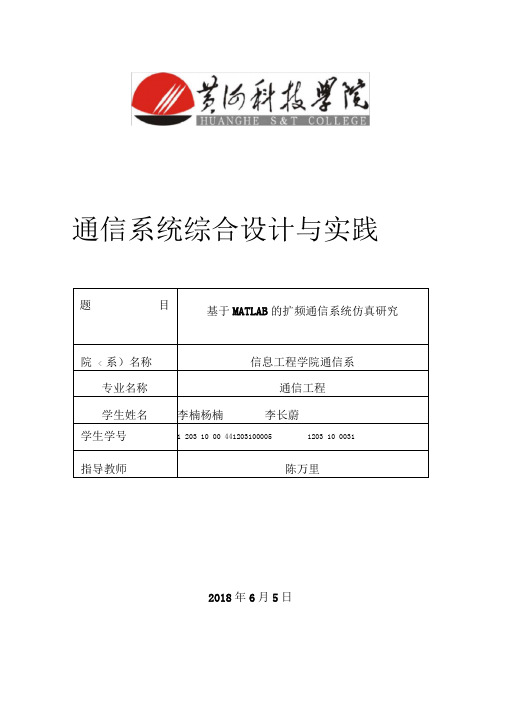
通信系统综合设计与实践2018年6月5日摘要目录......................... ……1 1、 设计目的 ...............2、 扩展频谱通信技术 2.1、理论基础 ..... 2.2、实现方 法3.立.2 、 系 统 仿 真 3模型 的 建 3.1、 Simulik 简介..33.2 、 模 型 建 立 及 主 要模块 设 33.3 、 几点 八、、 说 (4)、 仿 直 /、 结果 分 (4)4.1、 仿 直 /系 统 运 行 情 况 分..44.2 、 扩频 增 益 与 输 出 端 信噪比的 关 (5)结、.5 (2)2心得体会 (5)致谢 (6)参考文献 (7)基于MATLAB的扩频通信系统仿真研究摘要本文阐述了扩展频谱通信技术的理论基础和实现方法,利用MATLAB提供的可视化工具Simulink建立了扩频通信系统仿真模型,详细讲述了各模块的设计,并指出了仿真建模中要注意的问题。
在给定仿真条件下,运行了仿真程序,得到了预期的仿真结果。
同时,利用建立的仿真系统,研究了扩频增益与输出端信噪比的关系,结果表明,在相同误码率下,增大扩频增益,可以提高系统输出端的信噪比,从而提高通信系统的抗干扰能力。
关键词:扩频通信、信噪比、误码率、扩频增益Simulation of the Spread Spectrum Communication SystemBased on MATLABAbstract: The theory base and realizing methods of the spread spectrum com muni cati on tech no logy was prese nted in this study. The simulati on model of the spread spectrum com muni catio n system was built by using SIMULINK, which is provided by MATLAB. In addition, each module of the simulation model was introduced in detail,and pointed out the problems that must be pay attention to in the system simulation. On the basis of the designed simulation conditions, the simulati on program was run and the an ticipa nt results were gain ed. Moreover, the relati on ship betwee n the spread spectrum gain and the fan-out error rate was also studied by use of the simulation system. The results showed that on the base of the same error rate, if the spread spectrum gain was enlarged, the Signal-to-Noise of the system fan-out would be enhanced and the anti-jamming capability of the com municati on system would also be enhan ced.Keywords:spread spectrum commun icatio n, Sig nal-to-Noise, error rate, spread spectrum gain.1、设计目的扩展频谱通信<简称扩频通信)与光纤通信、卫星通信,一同被誉为进入信息时代的三大高技术通信传输方式,它是指发送的信息被展宽到一个很宽的频带上,在接收端通过相关接收,将信号恢复到信息带宽的一种系统。
通信原理MATLAB仿真教程第十章 扩频通信系统

图 10-3 相干检测原理图
18
图 10-4 相干参考信号产生原理图 本地参考信号是由锁相环路产生的,如 10-4 所示。用一个振荡器,其 频率与输入信号频率相近, 把它的相位与输入信号相位作比较(可以用鉴相 器实现),获得的误差电压称为误差信号,此误差信号经滤波平滑后,再作 用于振荡器,以不断纠正它的相位与输入信号的误差,于是这个受输入电 压控制的振荡器的输出振荡的相位,就逐渐逼近于输入信号的相位,达到 同频、同相的结果,它们之间近似的程度取决于跟踪误差。
N 1
c g
n n0
ห้องสมุดไป่ตู้
c
(t nTc )
(10-4)
式中, n 为伪随机码码元, c 取值 1 或 1 ; c (t ) 为门函数, g 定义与式(10-3) 类似。 扩频过程实质上是信息流 a t 与伪随机序列 c t 的模二加或相乘的过 程,伪随机码速率 Rc 比信息速率 Rd 大的多,一般 Rc / Rd 的比值为整数且 远大于 1 ,所以 扩展后 的序列 的速率 仍为伪 随机码 速率 Rc ,扩展的 序列
(10-8)
14
式中信号为 s (t ) ,信道噪声为 n(t ) ,干扰信号为 J (t ) ,其它网的扩频信 o 号为 s (t ) 。 J 对于信号分量为 s (t ) o
s ( t ) a ( t ) c( t ) c( t ) cos I t o
(10-9)
其中 I 为中频频率,若 本地产生的伪 随机序列 c(t ) 与发端产生的伪随机 序列 c (t ) 同步,有 c (t ) c(t ) ,则 c (t ) c(t ) 1 ,这样信号分量 s (t ) 为 o
基于Matlab的直序列和跳频扩频通信系统仿真

基于Matlab的直序列和跳频扩频通信系统仿真一、实验目的根据通信理论知识熟练的运用MATLAB进行直序列扩频和跳频扩频的仿真研究。
二、实验内容1.Matlab/simulink通信系统仿真。
2.用matlab实现直序列扩频和跳频扩频。
三、实验平台硬件平台:笔记本电脑软件平台:windows XP操作系统、Matlab R2014a四、扩频通信(一)理论基础通信技术和通信理论的研究,是围绕着通信系统的有效性和可靠性这两个基本问题开展的。
所以,有效性和可靠性是设计和评价一个通信系统的主要性能指标。
有效性,是指通信系统传输信息效率的高低。
这个问题是讨论怎样以最合理、最经济的方法传输最大数量的信息。
在模拟通信系统中,多路复用技术可提高系统的有效性。
显然,信道复用程度越高,系统传输信息的有效性就越好。
在数字通信系统中,由于传输的是数字信号,因此传输的有效性是用传输速率来衡量的。
可靠性,是指通信系统可靠地传输信息。
由于信息在传输过程中受到干扰,收到的与发出的信息并不完全相同。
可靠性就是用来衡量收到信息与发出信息的符合程度。
因此,可靠性决定于系统抵抗干扰的性能,也就是说,决定于通信系统的抗干扰性。
在模拟通信系统中,传输可靠性是用整个系统的输出信噪比来衡量的。
在数字通信系统中,传输可靠性是用差错率来衡量的。
扩展频谱通信由于具有很强的抗干扰能力,首先在军用通信系统中得到了应用。
近年来,扩展频谱通信技术的理论和应用发展非常迅速。
扩频通信是扩展频谱通信的简称。
我们知道,频谱是电信号的频域描述。
承载各种信息(如语音、图象、数据等)的信号一般都是以时域来表示的,即表示为一个时间的函数。
信号的时域表示式可以用傅立叶变换得到其频域表示式。
频域和时域的关系由式(1-1)确定:(1-1)函数的傅立叶变换存在的充分条件是满足狄里赫莱(Dirichlet)条件,或在区间(-∞,+∞)绝对可积,即必须为有限值。
扩展频谱通信系统是指待传输信息的频谱用某个特定的扩频函数(与待传输的信息码无关)扩展后成为宽频带信号,送入信道中传输,再利用相应的手段将其压缩,从而获取传输信息的通信系统。
直接序列扩频系统matlab仿真

仿真结果:展示扩频与解扩 频过程的效果图和性能指标
结论:分析仿真结果,总结 直接序列扩频系统的性能优
势和适用场景
系统性能评估与优化
评估指标:包括频谱效率、抗干扰性能、抗多径干扰能力等。
仿真实验:通过MATL AB进行仿真实验,对系统性能进行评估。 优化方法:针对仿真实验中存在的问题,提出相应的优化方法,提高系统 性能。 性能比较:将优化后的系统性能与其他同类系统进行比较,验证优化效果。
扩频增益分析
扩频增益定义:扩频增益是指扩频通信系统所提供的信噪比改善程度,是衡量扩频系统性能的重 要参数。
扩频增益计算方法:扩频增益可以通过计算扩频前后的信噪比来获得,即扩频前信噪比与扩频后 信噪比之比。
仿真结果分析:通过对直接序列扩频系统的 MATL AB仿真,可以获得扩频前后的信噪比数据,进 而计算出扩频增益。
MATL AB是一款由MathWorks公司开发的商业数学软件
它主要用于算法开发、数据可视化、数据分析以及数值计算
MATL AB提供了丰富的库函数和工具箱,方便用户进行各种计算和分析
在直接序列扩频系统的仿真中,MATL AB可以用于搭建仿真模型、生成扩频码以及进行信号处理 等操作
Simulink模块库介绍
调制与解调过程仿真
调制过程:将信息信号调制到载 波信号上,实现频谱的扩展
仿真实现:利用MATL AB编程实 现调制与解调过程的模拟
添加标题
添加标题
添加标题
添加标题
解调过程:将调制信号解调还原 成原始信息信号的过程
仿真结果分析:对仿真结果进行 性能分析和评估
扩频与解扩频过程仿真
解扩频过程:将接收到的信 号与相同的扩频码进行解调, 恢复出原始信号
- 1、下载文档前请自行甄别文档内容的完整性,平台不提供额外的编辑、内容补充、找答案等附加服务。
- 2、"仅部分预览"的文档,不可在线预览部分如存在完整性等问题,可反馈申请退款(可完整预览的文档不适用该条件!)。
- 3、如文档侵犯您的权益,请联系客服反馈,我们会尽快为您处理(人工客服工作时间:9:00-18:30)。
扩频通信系统的MATLAB仿真摘要扩频通信,即扩展频谱通信( Spread Spectrum Communication),它与光纤通信、卫星通信,一同被誉为进入信息时代的三大高技术通信传输方式。
本文详细阐述了扩展频谱通信的理论基础和实现方法,并通过Matlab对直扩通信系统进行了仿真,并对各基本模块进行设计和仿真。
此外,在给定仿真条件下,运行了仿真程序,得到了预期的仿真结果。
同时,利用建立的仿真系统,通过对比一般通信系统和基本扩频通信系统的仿真,研究了扩频通信系统抑制信道干扰和码间干扰的性能,结果表明,扩频通信系统确实能很好的提高通信系统的可靠性。
关键词:直扩通信;Matlab;Simulink;仿真Spread spectrum communication system simulation withMATLABAbstract. Spread spectrum communication, namely the spread spectrum communication (Spread Spectrum Communication), optical fiber communication and satellite communication is together known as the three high-tech communication transmission mode in the information age. This paper expounds the theoretical foundation and realization method of the spread spectrum communication. By the Matlab simulation platform, spread spectrum communication system is simulated, and each basic is designed and simulated as well. In addition, in a given simulation conditions, running the simulation program obtained the expected simulation results. At the same time, using the simulation system, by comparing the general communication system and the basic spread spectrum communication system simulation, studied the spread spectrum communication system to suppress channel interference and inter-symbol interference performance. The results showed that the spread spectrum communication system does good to improve the reliability of communication system.Key words: DSSS communication; Matlab ; Simulink ;Simulation目录摘要 (I)Abstract (II)前言 (1)1 绪论 (2)1.1 选题的背景 (2)1.2 选题的主要任务 (3)2 扩频通信系统 (4)2.1 扩频通信的定义 (4)2.2 扩频通信的理论基础 (5)2.3 扩频通信系统的工作原理 (7)2.4 扩频通信的主要特点 (8)2.5 扩频通信的主要性能指标 (10)2.5.1 处理增益 (10)2.5.2 抗干扰容限 (11)3 直接序列扩频通信的性能分析 (12)3.1 直接序列扩频通信系统概述 (12)3.2 直接序列扩频通信系统的数学模型 (13)3.3 多径干扰 (14)3.3.1 多径干扰的概念 (14)3.3.2直扩系统的抗干扰性 (15)3.3.3直扩系统的抗截获性 (16)3.3.4直扩码分多址通信系统 (17)3.3.5 直扩系统的抗多径能力 (17)3.4 直接序列扩频通信系统的伪随机码的选择 (18)3.4.1 扩频码简介 (19)3.4.2 m序列 (19)4 直接序列扩频通信系统的仿真基础 (25)4.1 Matlab语言与仿真环境介绍 (25)4.1.1 Matlab仿真环境简述 (25)4.1.2 Matlab语言介绍 (26)4.2 基于matlab通信仿真的基本步骤 (27)4.3 Simulink建模仿真的一般过程 (27)4.3.1 Simulink建模仿真的基本步骤 (27)4.3.2 Simulink中功能模块的连接及设置 (28)5 直接序列扩频通信系统的仿真 (32)5.1 Simulink的仿真 (32)5.1.1 扩频与解扩的Simulink仿真 (32)5.1.2 BPSK调制的Simulink仿真 (34)5.1.3 编码信道的Simulink仿真 (36)5.2 Matlab源程序设计 (38)总结 (48)致谢 (49)参考文献 (50)前言在当今信息时代,如何有效的利用宝贵的频带,如何进行准确可靠的信息通信是通信领域中至关重要的问题,扩频通信正是在这种背景下迅速发展起来的。
直接序列是扩频通信的一种实现方式,在抗干扰和保密方面,是扩频通信中很好的通信方式。
具体的实现方式是将待传送的信息数据经伪随机编码(扩频序列: Spread Sequence)调制,实现频谱扩展后再传输;接收端则采用相同的编码进行解调及相关处理,恢复原始信息数据。
本次毕业设计中,是用Matlab实现直接序列扩频通信系统的仿真。
Matlab是一种功能强大的软件,在统计、信号处理、人工智能以及通信领域得到了广泛的应用。
这篇论文共分五章:第一章是绪论部分,主要介绍选择该课题的背景及任务。
第二章主要介绍了扩频通信的基本定义、理论和主要性能指标。
第三章重点介绍直接序列扩频通信系统的性能分析,包括直接序列扩频通信的模型、多径干扰和伪随机码的选择。
第四章着重介绍直接序列扩频通信系统的仿真基础,主要包括Matlab语言与仿真环境介绍,基于Matlab通信仿真的基本步骤,Simulink建模仿真的一般过程。
第五章是对本课题的一系列相关的仿真,主要包括Simulink基本模块的仿真和扩频通信系统的仿真。
1 绪论1.1 选题的背景人类社会进入到了信息社会,通信现代化是人类社会进入信息时代的重要标志。
而在现代通信中遇到的一个重要问题就是抗干扰问题。
随着通信事业的迅速发展,各类通信网的建立,使得有限的频率资源更加拥挤,相互之间的干扰更为严重,如何防止和降低这种相互之间的干扰,就成为一大难题。
扩展频谱(SS ,Spread Spectrum,简称扩频)技术具有很强的抗干扰性,其多址能力、保密、抗多径等功能倍受人们的关注,被广泛的应用于军事通信和民用通信中。
扩频通信系统扩展频谱技术,将信号扩展到很宽的频带上,在接收端对扩频信号进行相关处理即带宽压缩,恢复成窄带信号。
对干扰信号而言,由于与扩频信号不相关,则被扩展到一个很宽的频带上,使之进入信号通频带内的干扰功率大大的降低,相应增加了相关器输出端的信号/干扰比,对大多数认为的干扰而言,扩频通信系统都具有很强的对抗能力。
扩频技术是二战期间开发的,最初的用途是为军事通信提供安全保障, 是美军重要的无线保密通信技术。
这种技术使敌人很难探测到信号。
即便探测到信号,如果不知道正确的编码,也不可能将噪声信号重新汇编成原始的信号。
有关扩频通信技术的观点是在1941年由好莱坞女演员Hedy Lamarr 和钢琴家George Antheil提出的。
基于对鱼雷控制的安全无线通信的思路,他们申请了美国专利#2.292.387。
不幸的是,当时该技术并没有引起美国军方的重视,直到十九世纪八十年代才引起关注,将它用于敌对环境中的无线通信系统。
真正实用的扩频通信系统是在50年代中期发展起来的。
麻省理工学院林肯实验室开发的扩频通信系统F9C-A/Rake系统被公认为第一个成功的扩频通信系统,在该系统的研制过程中,首次提出了瑞克(RAKE)接收的概念并成功应用,该系统也是第一个真正实用的宽带通信系统。
第一个跳频扩频通信系统BLADES也在这段时期研制成功,在该系统中第一次利用移位寄存序列实现纠错编码。
在此期间,喷气实验室(JPL)在其空间任务中完成了伪码产生器的设计以及跟踪环路的设计。
自从扩频通信的概念在50年代开始成熟以后,此后的二十多年扩频通信技术仍得到很大的发展,但都只是局部的发展,如硬件的改进和应用领域的拓展。
一直到80年代初期,扩频通信的概念都只是在军事通信系统中得到应用,这种状况到了80年代中期才得到改变。
美国联邦通信委员会(FCC)于1985年5月发布了一份关于将扩频技术应用到民用通信的报告。
从此,扩频通信技术获得了更加广阔的应用空间。
90年代初,在第一代模拟蜂窝通信系统的基础上,出现了PCS研究的热潮。
扩频技术为共享频谱提供了可能。
使用扩频技术能够实现码分多址,即在多用户通信系统中所有用户共享同一频段,但是通过给每个用户分配不同的扩频码实现多址通信。
利用扩频码的自相关特性能够实现对给定用户信号的正确接收;将其他用户的信号看作干扰,利用扩频码的互相关特性,能够有效抑制用户之间的干扰。
随着PCS(Personal Communications Service)以及蜂窝移动通信的发展,CDMA(Code Division Multiple Access)技术已经成为不可或缺的关键技术。
扩频通信技术也在民用通信中找到更为广阔的应用空间,而关于CDMA技术的研究热潮也一直延续到现在。
扩频技术由于其本身具备的优良性能而得到广泛应用,到目前为止,其最主要的两个应用领域仍是军事抗干扰通信和移动通信系统,而跳频系统与直接扩频系统则分别是在这两个领域应用最多的扩频方式。
直接扩频码分多址,由于具备通信容量大、能充分利用话音的统计特性、平滑的越区切换、通信容量的软特性等优点被作为未来移动通信中最具竞争力、最有前景的无线多址接入技术。
无线扩频通信作为另一种有效的补充通信手段,已在金融系统得到了越来越广泛的应用。
发展到现在,扩频技术理论和技术都已趋于完善,主要应从系统的角度考虑总体性能,且与其它新技术结合应用。
